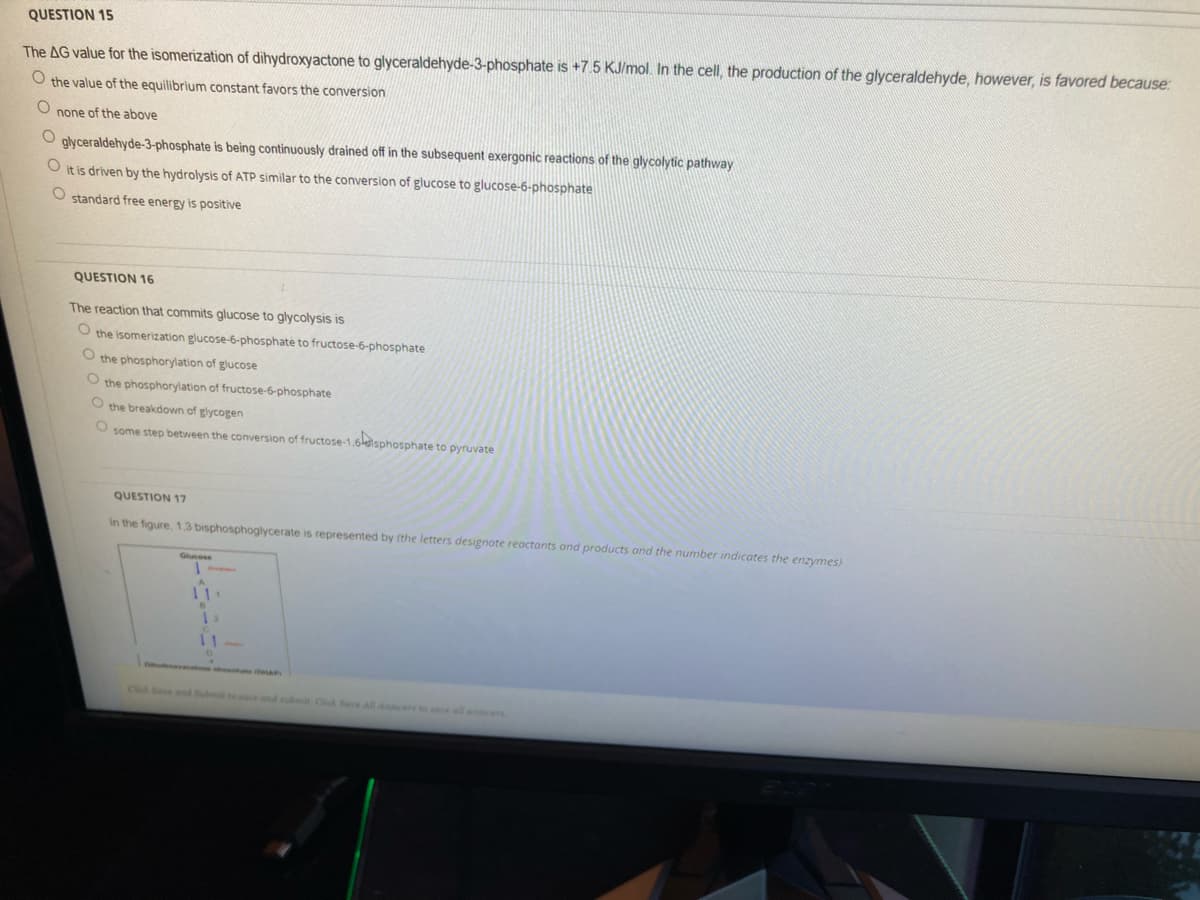the glyceraldehyde, however, is favored beca O the value of the equilibrium constant favors the conversion none of the above O glyceraldehyde-3-phosphate is being continuously drained off in the subsequent exergonic reactions of the glycolytic pathway O it is driven by the hydrolysis of ATP similar to the conversion of glucose to glucose-6-phosphate O standard free energy is positive
the glyceraldehyde, however, is favored beca O the value of the equilibrium constant favors the conversion none of the above O glyceraldehyde-3-phosphate is being continuously drained off in the subsequent exergonic reactions of the glycolytic pathway O it is driven by the hydrolysis of ATP similar to the conversion of glucose to glucose-6-phosphate O standard free energy is positive
Introduction to General, Organic and Biochemistry
11th Edition
ISBN:9781285869759
Author:Frederick A. Bettelheim, William H. Brown, Mary K. Campbell, Shawn O. Farrell, Omar Torres
Publisher:Frederick A. Bettelheim, William H. Brown, Mary K. Campbell, Shawn O. Farrell, Omar Torres
Chapter20: Carbohydrates
Section: Chapter Questions
Problem 20.83P
Related questions
Concept explainers
Organic Chemistry of Metabolic Pathways
Metabolic pathways allude to the arrangement of chemical catalyzed reactions that lead to the transformation of a substance into the final product. Metabolic pathways incorporate a progression of reaction where the substrate is changed continuously and the transitional metabolites are persistently recovered.
Glucogenesis
Glucogenesis is a metabolic pathway in which glucose is produced from carbon substrates that are not carbohydrates. This process is observed in plants, animals, fungi, bacteria and other micro organisms. The general definition for glucogenesis or gluconeogenesis is as follows,
Question
15

Transcribed Image Text:QUESTION 15
The AG value for the isomerization of dihydroxyactone to glyceraldehyde-3-phosphate is +7.5 KJ/mol. In the cell, the production of the glyceraldehyde, however, is favored because:
O the value of the equilibrium constant favors the conversion
none of the above
glyceraldehyde-3-phosphate is being continuously drained off in the subsequent exergonic reactions of the glycolytic pathway
it is driven by the hydrolysis of ATP similar to the conversion of glucose to glucose-6-phosphate
O standard free energy is positive
QUESTION 16
The reaction that commits glucose to glycolysis is
the isomerization glucose-6-phosphate to fructose-6-phosphate
O the phosphorylation of glucose
O the phosphorylation of fructose-6-phosphate
O the breakdown of glycogen
O some step between the conversion of fructose-1,6sphosphate to pyruvate
QUESTION 17
In the figure, 1,3 bisphosphoglycerate is represented by (the letters designate reactants and products and the number indicates the enzymes)
Glucese
te i A
Cl Se nd Sub to and ubmi C Seve All Aners to all anncens
Expert Solution
This question has been solved!
Explore an expertly crafted, step-by-step solution for a thorough understanding of key concepts.
Step by step
Solved in 2 steps

Knowledge Booster
Learn more about
Need a deep-dive on the concept behind this application? Look no further. Learn more about this topic, chemistry and related others by exploring similar questions and additional content below.Recommended textbooks for you

Introduction to General, Organic and Biochemistry
Chemistry
ISBN:
9781285869759
Author:
Frederick A. Bettelheim, William H. Brown, Mary K. Campbell, Shawn O. Farrell, Omar Torres
Publisher:
Cengage Learning

Principles of Instrumental Analysis
Chemistry
ISBN:
9781305577213
Author:
Douglas A. Skoog, F. James Holler, Stanley R. Crouch
Publisher:
Cengage Learning


Introduction to General, Organic and Biochemistry
Chemistry
ISBN:
9781285869759
Author:
Frederick A. Bettelheim, William H. Brown, Mary K. Campbell, Shawn O. Farrell, Omar Torres
Publisher:
Cengage Learning

Principles of Instrumental Analysis
Chemistry
ISBN:
9781305577213
Author:
Douglas A. Skoog, F. James Holler, Stanley R. Crouch
Publisher:
Cengage Learning
